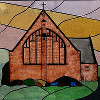The Presentation Luke 2:22-40
The turn of the Millennium now seems a long time ago. For me, one of the highlights was an exhibition at the National Gallery in London. It was put together by Neil MacGregor and its title was Seeing Salvation. In the introduction to the book that he wrote to accompany a television series about the exhibition, Neil MacGregor quoted words from today’s Gospel:
“Lord, now lettest thou thy servant depart in peace, according to thy word: For mine eyes have seen thy salvation.”
He went on:
“With these words this book begins and ends. They were spoken by the old priest Simeon as he took the infant Jesus in his arms and saw in him the Saviour. In this child, Christians believe, the boundaries of the human and divine were permanently redrawn for us all.”
The book closes with a meditation on Rembrandt’s Nunc Dimittis, which can be found in the National Museum in Stockholm. It is a work of his later years. The picture is tightly-cropped. We see only Simeon, the Christ child whom he holds in his arms and, over Simeon’s left shoulder, the face of Anna, looming out of a dark background. The old man’s eyes appear, at first glance, to be closed, and it is only when one looks again that one sees that his hands are coming together in a gesture of prayer, and that his eyes are directed downwards towards the child in his arms who is the Son of God. The expression on his face is rapt. His mouth is slightly open, and his whole countenance is filled with a quiet wonder and worship.
Only two parts of the picture have anything approaching a finished quality – the prayerful face of Simeon and the right hand, chest and face of the infant Jesus. It is as though the baby is the only fully realised reality, a source of light in the picture, a reality that is perceived by the old man and a light that is reflected in his countenance.
Neil MacGregor writes of Rembrandt’s Simeon:
“…although he appears to be blind, he sees the essential. He intuits divinity and he knows all will now be well….“Lord, now lettest thou thy servant depart in peace, according to thy word: For mine eyes have seen thy salvation.”
Seeing Salvation is not always, perhaps not often, easy. It ought to be easier for us than for Simeon and Anna. They waited in expectant hope, trusting God’s purposes but ignorant of how those purposes would ripen. We believe and know that God has intervened decisively in history in Jesus Christ, that the boundaries between the human and the divine have been redrawn. We view that intervention in and through Resurrection light. Yet we still find it difficult, especially when life confronts us with painful realities.
Today’s Gospel speaks to us of that spirituality that enables us to see Salvation with the clarity, the certainty and the joy of Simeon and Anna. How balanced Luke’s narrative is. The two people who are able to see salvation are a man and a woman, One of them, Simeon, is in the Temple that day because he has been guided there by the Holy Spirit. The other, Anna, is a person whom, we are told, never left the Temple but worshipped there with fasting and prayer night and day. It is almost as though Luke is telling us that what we would call two very different kinds of churchmanship, the one charismatic, Spirit-led, inspirational, the other disciplined, regular, almost monastic, both confer the gift of recognition, the ability to see salvation. But they have two important things in common. Firstly, both are devout. Secondly, it is in the Temple that they have the encounter in which they see salvation. That ability to see is something that we can cultivate, both in the private prayer which creates the space in which the Holy Spirit can speak to us and in the joyous discipline of public, corporate worship which builds us up in faith and love.
To return to Rembrandt’s painting:
The baby is the only fully realised reality, a reality that is perceived by the old man and reflected in his countenance. Candlemas – the Feast of the Presentation – offers us the opportunity to reflect on the coming of Christ into the world, the coming of the light that the darkness has not overcome. It is also a reminder that our calling is to reflect that light on a world sorely in need of illumination. As we turn away from Christmas and move towards Lent and Easter, we will be exploring what that means.
